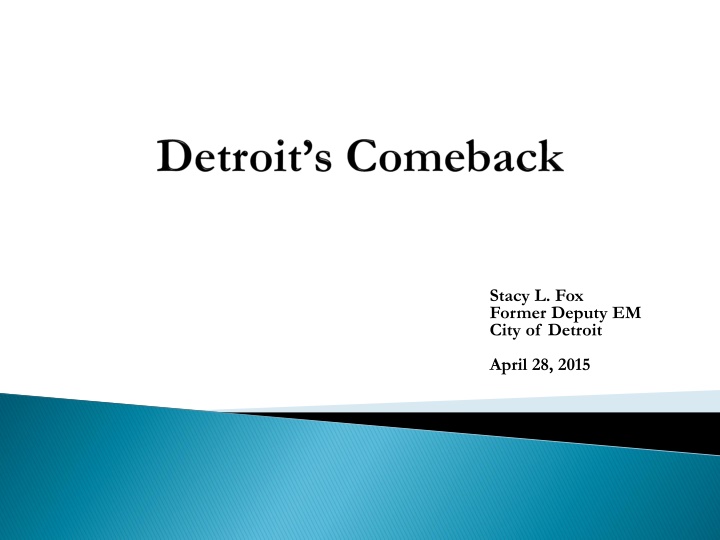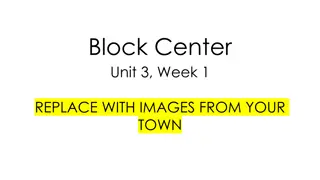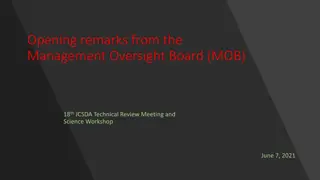
Detroit City Financial Analysis and Challenges
Explore the financial challenges faced by the City of Detroit, including declining population, revenue sources, high unemployment, crime rates, and deteriorating infrastructure. Learn about the city's accumulated deficit, resolution efforts, and general fund capitalization.
Download Presentation

Please find below an Image/Link to download the presentation.
The content on the website is provided AS IS for your information and personal use only. It may not be sold, licensed, or shared on other websites without obtaining consent from the author. If you encounter any issues during the download, it is possible that the publisher has removed the file from their server.
You are allowed to download the files provided on this website for personal or commercial use, subject to the condition that they are used lawfully. All files are the property of their respective owners.
The content on the website is provided AS IS for your information and personal use only. It may not be sold, licensed, or shared on other websites without obtaining consent from the author.
E N D
Presentation Transcript
Stacy L. Fox Former Deputy EM City of Detroit April 28, 2015
Over the past several decades, the Citys population has declined over 60% 2,000 1,850 1,800 1,670 1,600 1,511 1,400 1,203 1,200 (Population in 000's) 1,028 951 1,000 800 714 685 600 400 200 - JUN-50 JUN-60 JUN-70 JUN-80 JUN-90 JUN-00 JUN-10 DEC-12 2
Detroit has more revenue sources, but less revenue State-shared Revenue Revenue from taxes Fee and Service Revenue 1960 Total Revenue: $2 Billion (in 2013 dollars) Fees, sale of services and other revenue 35% State-shared revenue 16% Property taxes 49% 2012 Total Revenue: $1.1 Billion (in 2013 dollars) Fees, sale of services and other revenue 30 % State- shared Revenue 16% Property Taxes 13% Income Taxes 21% Wagering Taxes 16% Utility Taxes 4% 3
High unemployment High crime rates Crumbling infrastructure Inadequate city services Inability to compete with suburbs 4
Detroits deteriorating financial condition continued to grow as legacy expenditures absorbed additional resources ($ in millions) $800 $700 $130 $600 $250 $500 $250 $400 $250 $75 $300 $75 $250 $75 $75 $200 $75 $327 $267 $75 $245 $100 $197 $142 $91 $91 $0 2007 A 2008 A 2009 A 2010 A 2011 A 2012 A 2013 P Accumulated Deficit LTGO Series 2008A LTGO Series 2010 LTGO Series 2012C 5
Resolution through Mediation Mayoral Election Ruling on Pensions Grand Bargain Pensioner Vote 6
General Fund Pro Forma Capitalization $12,000 Total: $10,506b Other $280 COPS Swap $290 $10,000 UTGO $488 $543 LTGO COPS $1,473 $8,000 $6,000 Pension $3,129 $4,000 Total: $3,300b $275 Exit Financing Other $90 UTGO $388 OPEB $4,303 $2,000 $1,100 LTGO Pension $1,447 $0 Pre-Petition Pro Forma 7
General Fund 10 Year Pro Forma Revenues and Expenditures Revenues $11.2b Expenditures $11.2b 12 Expenditures $14.3b Revenues $10.46b Revenues $0.8b 10 Operating expenditures $7.5b 8 (in $billions) Operating expenditures $7.5b 6 Revenues $10.4b 4 Reinvestment exp. $1.7b 2 Legacy exp. $2.1b Legacy exp. $6.9b - $3.9b deficit (2) (4) Without Restructuring With Restructuring (6) 8
Financial Summary of Reinvestment Initiatives Ten-Year Total $2,000M $37.7M Reorganization Implementation Costs $225.3M Capital Expenditure Reinvestment $1,500M $151.7M Technology Infrastructure Reinvestment $167.4M Fleet Reinvestment $1,717.8M $1,000M $715.7M Additional Operating Expenditures $500M $876.7M $420.0M Blight $0M -$482.9M Department Revenue Initiatives -$841.1M -$500M -$358.2M Department Cost Savings Initiatives -$1,000M 9
State of the City Post-bankruptcy Done: Restructured balance sheet Certain outsourcing Public Lighting Authority Great Lakes Water Authority In Progress with good results: City service improvements Operating Land Bank Blight demolition on-going Challenges: Further outsourcing Organizational restructuring Continued population decline due to structural and service disadvantages Ensuring the City stays on track 10
Questions? 11






















